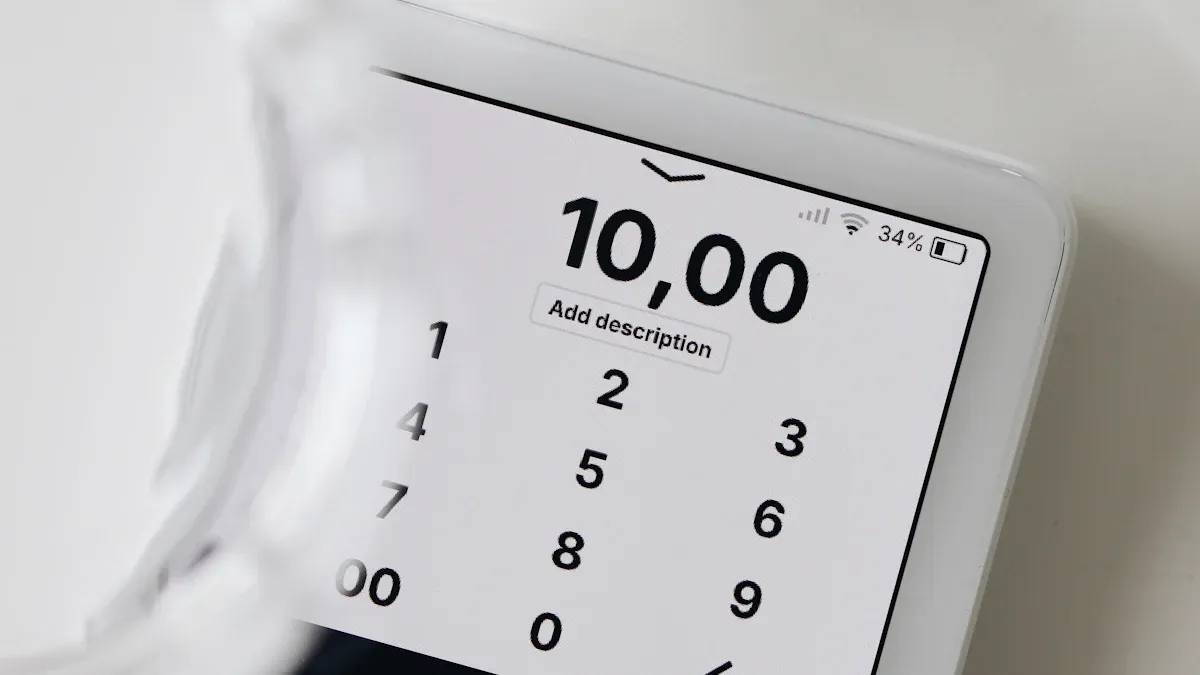
Drug stores operate in a fast-paced environment where digital price tags can transform daily operations. Many pharmacy teams encounter frequent price changes and regulatory updates. Before digital price tags, updating prices could take days. Now, digital systems like Electronic Shelf Labels and the ESL Gateway AP enable instant or scheduled updates, which minimizes downtime and improves accuracy. Customers expect a seamless experience, and digital solutions help stores deliver real-time information. Pharmacy teams benefit from synchronized pricing with POS systems, ensuring compliance and building trust. Esl Retail and ESL Price Tag technology let stores adapt quickly, creating a better experience for both staff and shoppers.
Digital Price Tags: Key Benefits for Drug Stores

Real-Time Price Updates and Compliance
Dynamic Pricing and Instant Updates
Digital price tags empower stores to update prices instantly across every shelf. Retailers can adjust prices based on demand, competitor activity, or product expiration. This flexibility helps stores reduce waste and attract price-sensitive customers. Digital systems allow prices to change as often as every ten seconds, supporting dynamic pricing strategies. Retail teams benefit from integration with inventory management, which optimizes stock levels and turnover. These features help stores remain competitive and profitable in a fast-moving retail environment.
Meeting Regulatory Requirements
- Digital price tags enable real-time, remote price updates, ensuring immediate compliance with government-mandated changes.
- They reduce manual errors, providing greater pricing accuracy and transparency.
- Consistent pricing across multiple locations supports regulatory compliance.
- Integration with inventory and pricing management systems enhances adherence to strict drug pricing laws.
- These features prove especially valuable in regions with stringent regulations, such as the U.S. and the EU.
Labor Savings and Error Reduction with Digital Price Tags
Automating Price Changes
Digital price tags automate the process of updating shelf prices. Retail employees no longer need to walk the aisles to replace paper tags. This automation increases productivity and allows staff to focus on customer service. Faster restocking and fewer manual tasks improve operational efficiency. As labor costs rise, stores see even greater value from digital solutions.
Reducing Human Error
Automation reduces human pricing errors by nearly 58%. Digital price tags synchronize prices between shelves and registers, increasing accuracy by about 60%. This consistency prevents pricing disputes and creates a more professional store image. Retailers report fewer mistakes and a smoother checkout process, which enhances the overall experience for both staff and customers.
Enhancing Customer Experience with Digital Price Tags
Clear and Accurate Shelf Information
Digital price tags provide clear, accurate, and up-to-date information at the shelf. Customers see the same price at checkout as they do on the shelf, reducing confusion. Digital shelf displays can show barcodes, safety warnings, ingredient lists, and expiration dates. This transparency helps customers make informed decisions and supports compliance in the pharmacy sector.
Building Trust and Loyalty
Accurate pricing and compliance foster customer trust. Digital price tags eliminate mismatches between shelf and checkout prices, reducing frustration. Informative labels and real-time updates demonstrate honest business practices. While service quality remains the main driver of loyalty in pharmacy retail, digital solutions contribute to an enhanced customer experience by improving transparency and safety.
Tip: Interactive features like QR codes on digital price tags can provide additional product details, supporting an enhanced customer experience and helping stores stand out in a competitive retail market.
Digital Price Tags: Potential Drawbacks and Challenges
Upfront and Ongoing Costs of Digital Price Tags
Initial Investment Considerations
Retail pharmacies face significant upfront costs when adopting digital solutions. The initial investment includes purchasing electronic shelf labels, installing wireless access points, and integrating cloud-based management platforms. Hardware installation remains minimal, but the cost per screen and the need for robust infrastructure can add up quickly. Many stores must also budget for IT consultation and system customization to ensure a seamless experience.
Maintenance and Upgrade Expenses
Ongoing expenses for digital systems differ from traditional paper-based pricing.
- Software licensing fees typically range from $10 to $50 per month for basic packages.
- Annual maintenance fees can reach $100 to $500 per screen.
- Battery replacements, repairs, and staff training add to the total cost.
- Stores benefit from lower ongoing costs compared to manual labeling, as digital systems reduce labor, printing, and physical tag replacement.
- Maintenance costs remain more predictable and often lower over time, especially for stores with frequent price changes and compliance needs.
Note: Digital price tags also support sustainability by reducing paper and plastic waste, which can lead to indirect cost savings for retail operations.
Technical Requirements and Staff Training for Digital Price Tags
System Setup and Integration
Retail pharmacies require a solid technical foundation for digital shelf labels.
- Core hardware includes electronic shelf labels and wireless access points.
- Cloud-based management platforms enable centralized control and real-time updates.
- Wireless communication supports instant price and promotion updates.
- Integration with AI and machine learning can automate pricing and inventory management.
- Battery life and durability, such as LCD tags with up to 10-year batteries, are critical for minimizing disruptions.
Training and Change Management
Staff experience challenges when adapting to new digital systems.
- Many employees report dissatisfaction with complex user interfaces, highlighting the need for clear visual aids and simplified workflows.
- Proper onboarding and ongoing training are essential for effective use.
- Persistent communication and education help address concerns about increased workload.
- IT support, including help desks and digital adoption platforms, assists staff in overcoming technical issues.
- Training gaps can hinder productivity and limit the expected efficiency gains from digital health technologies.
Integrating Digital Price Tags with Existing Systems
POS and Software Compatibility
Successful integration with existing POS systems ensures a smooth retail experience.
- Assess POS compatibility for API integration with electronic shelf labels.
- Plan the integration process with IT professionals, mapping data flow and requirements.
- Customize API solutions for the specific retail environment.
- Conduct thorough testing for accurate and timely price updates.
- Train staff to use the integrated system confidently.
- Monitor and optimize system performance continuously.
Integration reduces manual labor, speeds up pricing updates, and maintains a single source of truth for pricing data. This process enhances customer trust by ensuring shelf and checkout prices match.
Data Management and Security
Digital systems introduce new data security and privacy concerns for retail pharmacies.
- Real-time updates, facial recognition, and loyalty programs can raise privacy risks, such as unauthorized data collection or discriminatory pricing.
- Retailers must select vendors who meet strict security standards and maintain updated security policies.
- Protecting personally identifiable and health information is essential.
- Staff training on security best practices helps prevent cyberattacks.
- Compliance with federal and state laws, including HIPAA, mitigates the risk of data breaches.
Tip: Cybersecurity compliance and insurance costs are minimal compared to the consequences of a breach, making proactive security investments essential for retail pharmacies.
Digital Price Tags Suitability Checklist for Drug Stores
Store Size and Product Turnover
Small vs. Large Drug Stores
Store size plays a major role in determining the suitability of digital solutions. Smaller retail pharmacies often manage fewer products and can benefit from Bluetooth-based tags, which staff can control using smartphones or tablets. This approach reduces infrastructure costs and simplifies management. Larger retail stores or pharmacy chains, on the other hand, require more advanced connectivity, such as RF or Wi-Fi, to enable centralized control and remote management across multiple locations. The initial investment for large stores is higher due to the volume of inventory, but the operational efficiency gains and consistent pricing across branches can justify the expense over time.
| Factor | Small to Medium Stores | Large Stores / Chains |
|---|---|---|
| Connectivity Technology | Bluetooth-based tags managed via smartphones/tablets, reducing infrastructure costs | RF or Wi-Fi connectivity enabling centralized control and remote management |
| Cost of Implementation | Lower initial infrastructure cost | Higher initial cost due to large inventories |
| Operational Efficiency Gains | Easier management, reduced labor costs | Real-time updates, consistent pricing across multiple locations |
| Return on Investment | Cost-effective for smaller scale | Higher volume of tags offsets initial cost over time |
Smaller stores may see a quicker return on investment due to lower upfront costs. Larger stores, with more complex operations, can offset higher initial expenses through long-term labor savings and improved pricing accuracy.
High vs. Low Product Turnover
Retail environments with high product turnover experience frequent price changes and inventory updates. Digital solutions provide these stores with real-time updates, reducing manual labor and minimizing errors. High-turnover stores also benefit from improved stock management, which leads to better customer experience and increased profit. In contrast, stores with low product turnover may not require frequent price adjustments. For these stores, the investment in digital technology may take longer to pay off, and the operational benefits may be less pronounced.
Regulatory Needs and Pricing Complexity
Frequency of Price Changes
Pharmacy teams in retail settings often face rapid shifts in drug pricing. Regulatory changes, manufacturer updates, and market competition drive frequent adjustments. Digital systems allow stores to update prices instantly, ensuring compliance and reducing the risk of outdated information. This capability proves essential for stores operating in regions with strict pricing regulations or those that manage a wide range of products.
Compliance and Labeling Demands
Regulatory requirements for drug pricing continue to evolve. Many states have enacted laws that require drug manufacturers to disclose pricing information and justify increases. Proposed federal legislation aims to mandate price disclosures in drug advertisements, increasing transparency for consumers. Retail pharmacies must adapt to these changes to remain compliant and competitive. Digital tools help stores communicate pricing more effectively and improve consumer convenience.
- Several states require transparency in drug pricing, increasing the need for accurate and timely updates.
- Federal proposals seek to enhance consumer awareness by mandating price disclosures.
- Regulatory emphasis on transparency helps consumers understand out-of-pocket costs, influencing their choices.
- Retail pharmacies face competition from online and mail-order services, pushing them to adopt digital solutions.
- Digital tools, including price tags, help stores capture consumer attention and improve transparency at the point of sale.
Despite these efforts, only about 40% of consumers notice price disclosures in advertisements. Recognition varies by demographic factors, and price transparency alone may not suffice for all shoppers. Pharmacies can use digital displays to make price information more visible and accessible, improving the overall experience and supporting compliance.
Budget and ROI Expectations for Digital Price Tags
Cost-Benefit Analysis
Retail stores must weigh the initial investment against long-term benefits. The cost of implementing digital solutions can be significant, especially for large inventories. However, the ability to update prices quickly, reduce labor costs, and improve pricing accuracy can offset these expenses over time. High-volume stores often see greater operational efficiency and profit gains, while smaller stores may achieve cost-effectiveness on a smaller scale.
Tip: Retailers should consider both direct and indirect savings, such as reduced paper waste and improved staff productivity, when evaluating the total value of digital investments.
Calculating Payback Period
Calculating the payback period helps retail pharmacies determine when they will start to see profit from their investment. Stores should estimate the total cost of hardware, software, training, and maintenance. Next, they should project annual savings from reduced labor, fewer pricing errors, and improved inventory management. High-turnover stores or those with frequent price changes typically achieve a faster payback period. Low-turnover stores may need to wait longer to realize a return, but they still benefit from improved compliance and customer experience.
A clear understanding of these financial metrics allows retail teams to make informed decisions about digital adoption. By aligning investment with operational needs and regulatory demands, stores can maximize both profit and customer experience.
Digital Price Tags in Action: Case Scenarios

When Digital Price Tags Make Sense Now
High Volume and Frequent Price Adjustments
Retail pharmacies with high product turnover and frequent price changes benefit most from digital price tags. These stores often manage complex pricing structures and must update information quickly to remain competitive. Digital solutions allow real-time updates, which support dynamic pricing and compliance with regulatory changes. Teams in these environments see improved workflow transparency and operational efficiency.
- Digital price tags display pharmacist names and medication quantities, which enhances prescription dispensing accuracy.
- Real-time expiry date alerts with flashing indicators prevent the sale of expired medications.
- Pharmacist identification and status updates track the entire dispensing process, improving workflow transparency.
- Simultaneous, paperless inventory checks transmit data instantly to central systems, streamlining inventory management.
- Barcode scanning and shelf lighting automate restocking, ensuring correct medication placement.
- Accurate pricing and real-time stock updates improve the customer experience and satisfaction.
Retail stores with these operational demands often achieve a faster return on investment. Digital systems automate price updates, reducing labor costs by up to 90%. This efficiency is especially valuable for stores that must respond quickly to market changes.
Labor Shortages or High Labor Costs
Many retail pharmacies face labor shortages or rising labor costs. Digital price tags reduce the need for manual price changes, freeing staff to focus on customer service and other critical tasks. Automated workflows minimize human error and support a more professional store environment.
Digital price tags confirm drug dispensing workflows through pharmacist identification and queue status updates, which ensures clear and efficient processes.
Retail teams report smoother operations and fewer pricing disputes. The enhanced customer experience builds trust and loyalty, which is essential in competitive retail markets.
When to Wait or Reconsider Digital Price Tags
Limited Budget or Low Product Turnover
Some stores may need to delay digital adoption due to budget constraints or low product turnover. Digital price tags require a significant upfront investment, with unit costs ranging from $5 to over $100 depending on features. Stores with simple pricing structures or infrequent price changes may not realize immediate savings.
- Subscription and leasing models offer financial flexibility, but stores must evaluate their long-term needs.
- ROI typically occurs within 12 to 24 months, driven by labor, printing, and error reduction savings.
- Stores with low turnover may experience a longer payback period.
Retail environments with limited budgets should carefully assess whether digital solutions align with their operational goals.
Simple Pricing Structures and Minimal Compliance Needs
Stores with straightforward pricing and minimal regulatory demands may not require advanced digital features. These stores still benefit from operational efficiencies, such as reduced labor costs and improved pricing accuracy, but the value of dynamic pricing tools may be limited.
- Digital price tags automate updates, which reduces labor costs and enhances the customer experience.
- Stores with complex pricing gain additional value from flexible pricing strategies, while simple pricing stores focus on operational excellence.
- Enhanced customer experience through accurate pricing and product information remains a universal benefit.
Retail pharmacies should match their digital investment to their pricing complexity and compliance requirements to maximize value.
Digital price tags offer a modern solution for stores that want to improve the experience for both staff and customers. Many stores in the retail sector face frequent price changes and complex compliance needs. Digital systems help stores manage these challenges and create a better experience. Stores with high labor demands or complex pricing see the most benefit. Smaller stores may wait until digital costs decrease. Every store should use the suitability checklist to decide if digital price tags fit their experience. Research vendors, estimate ROI, and consider a pilot program to test the experience in your stores. The right digital choice can transform the experience in retail stores and set a new standard for customer experience.
FAQ
What are digital price tags, and how do they work in drug stores?
Digital price tags use electronic displays to show product prices and information. Staff can update these tags remotely through a central system. This technology improves the experience for both employees and customers by ensuring accurate and timely pricing in stores.
How do digital price tags improve the customer experience?
Digital price tags provide real-time, accurate information at the shelf. Customers see the same price at checkout as on the shelf. This consistency builds trust and creates a positive experience, making stores more reliable for shoppers.
Can digital price tags help stores meet regulatory requirements?
Digital price tags allow stores to update prices instantly to comply with changing regulations. This feature reduces manual errors and ensures that every customer has the correct experience at the point of sale.
What challenges might stores face when adopting digital price tags?
Stores may encounter high initial costs, technical setup needs, and staff training requirements. These challenges can affect the overall experience during the transition. Proper planning and support help minimize disruptions.
How do digital price tags affect staff workload and experience?
Digital price tags automate price changes, reducing manual tasks for staff. Employees spend less time updating shelves and more time helping customers. This shift improves the work experience and increases productivity in stores.
Are digital price tags suitable for all drug stores?
Not every store benefits equally. Stores with frequent price changes or complex pricing structures gain the most from digital price tags. Smaller stores with simple pricing may not see the same improvement in experience or return on investment.
How do digital price tags support inventory management and the overall experience?
Digital price tags integrate with inventory systems, providing real-time stock updates. Staff can track products more efficiently, which improves the experience for both employees and customers. Accurate inventory data helps stores avoid stockouts and overstock situations.
What steps should stores take before implementing digital price tags?
Stores should assess their needs, estimate costs, and consider a pilot program. Evaluating the expected experience improvements and return on investment helps decision-makers choose the right solution for their environment.


